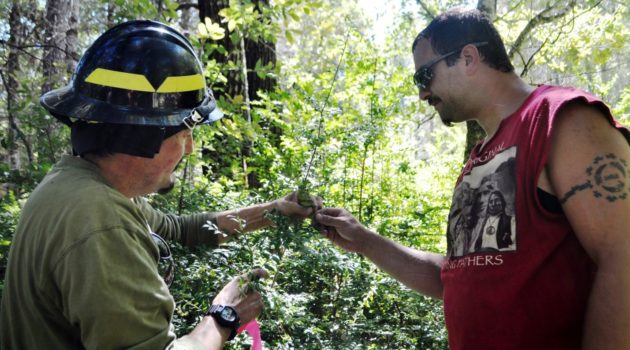
The FAC article reminded me of this story in the Colorado Springs Gazette:
This is the story of how Rich Snyder, a plumber and artist with a semi-nomadic lifestyle, came to reckon with America’s sins and reparations. Though he didn’t know it then, he would soon become one of the only people in the United States to pay reparations in land, an idea with growing popularity among indigenous scholars.
I know it’s an unpopular idea, but if people are talking about different kinds of land reparation for Native American Tribes, perhaps we should talk about whether (some part) of public lands (with what restrictions) should be on the table.
Anyway, back to the FAC post:
“This is the thing: If you have the option to not think about or even consider history, whether you learned it right or not, or whether it even deserves consideration, that’s how you know you’re on board the ship that serves hors d’oeuvres and fluffs your pillows, while others are out at sea, swimming or drowning, or clinging to little inflatable rafts that they have to take turns keeping inflated, people short of breath, who’ve never even heard of the words hors d’oeuvres or fluff.”
-Tommy Orange, There, ThereIf you’re working on fire adaptation, you should be pursuing respectful ways to learn about cultural burning. It’s part of this country’s history and ecology. The effectiveness of it as a stewardship tool has stood the test of time (Taylor et al., 2016 and Roos et al., 2018), and so have the horrendous implications of banning it.
A huge part of our wildfire problem has to do with denying indigenous communities of their right to burn their lands. It’s our duty as FAC practitioners to learn everything that indigenous communities want to teach us (without prying or taking advantage of the knowledge they do share) about cultural burning so that we can be better allies in their re-empowerment to steward their lands. I recently met Chook-Chook Hillman of the Karuk Tribe, and he put it this way: “Instead of asking, ‘How do you do X?’ start with, ‘Is it OK for me to know about X?’”
If you haven’t read it already, check out the United Nations Declaration on the Rights of Indigenous Peoples (which can be accessed online within a website dedicated to the declaration, or as a PDF — 150KB). Over a third of the articles within it discuss protecting and preserving indigenous culture. Like many UN declarations, it’s not legally binding, but it does establish impactful expectations and frameworks, and it has helped some countries better observe the rights of indigenous peoples. Here’s a helpful FAQ on it as well (PDF, 220KB).
………………….
Bill Tripp provides four examples of species who depend on fire, who the Karuk people in turn depend on (and steward with fire) in his blog, Integrating Traditional Ecological Knowledge and World Renewal Ceremonies into Fire Adaptation: An Indigenous Stewardship Model.
Wildfire mitigation efforts led by the Apache tribe provide an excellent example of when #wildfiremitigationworks. Or, as the Washington Times put it in their article, Apaches Stave Off Wildfires with Timber Industry, Active Forest Management:
“The catastrophic blazes that thrive in eastern Arizona’s thickly forested yet arid landscape have a way of fizzling once they jump from the dense national forests to the Apache reservations, and that’s not by chance.”
In Wildfire Prevention in Indian Country: Saving Lives While Respecting Tribal Lands, published by Indian Country Today, Jonathan Brooks, tribal forest manager with the Bureau of Indian Affairs’ Fort Apache Agency elaborates further:
“We have embraced a history, a culture, and a need for forest management to create a sustainable forest landscape adapted to the needs, demands and objectives of the White Mountain Apache Tribe and the forest itself that provides food, water, medicine and materials for survival as well as employment and economic gains for our people.
Sure does contradict a lot of the statements in the LA Times article posted by Matthew here https://forestpolicypub.com/2019/09/11/la-times-forest-thinning-projects-wont-stop-the-worst-wildfires-so-why-is-california-spending-millions-on-them/
The jist of the LA Times article seems to be “let it burn”. What the scientists quoted don’t seem to understand is their conclusions are based on a data set where there was minimal critical mass of forest management.
On the other hand, a data set based on those lands in this post where Native Americans have been allowed to carry out traditional forest management practices produces lands where “The catastrophic blazes that thrive in eastern Arizona’s thickly forested yet arid landscape have a way of fizzling once they jump from the dense national forests to the Apache reservations, and that’s not by chance.”
In addition, those quoted in the article posted here https://forestpolicypub.com/2019/09/10/are-wildland-fires-increasing-large-patches-of-complex-early-seral-forest-habitat/ don’t seem to understand that one of the most basic principles of wildlife management & forest regeneration is the concept of increased edge effect & structural (age/height) diversity which results from more & therefore smaller interspersed patches providing more adjacency for access to habitat diversity. The patchiness / structural diversity inside a large catastrophic fire and the edge effect are significantly less than in a forest that is sustainably manged to keep stand densities & stand age/height heterogeneity at a level that will significantly reduce the risk of loss to insects, disease & wildfire as well as reducing the loss of life & health of those who live thousands of miles downwind.